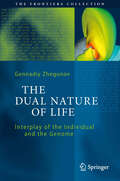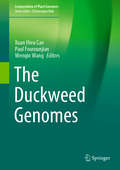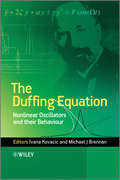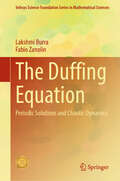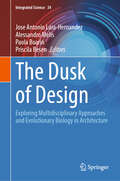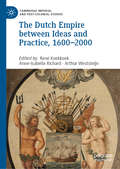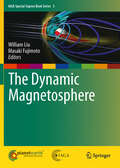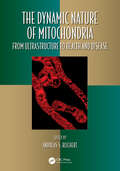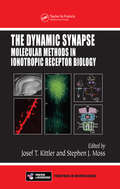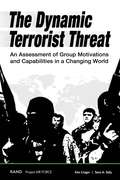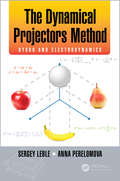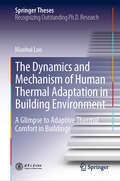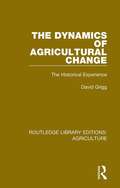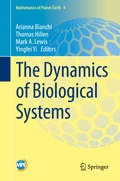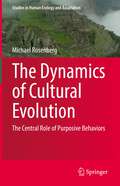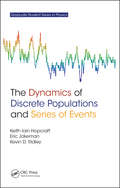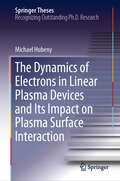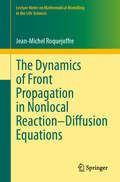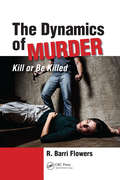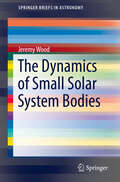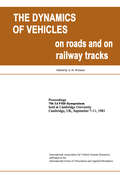- Table View
- List View
The Dual Nature of Life
by Gennadiy ZhegunovLife is a diverse and ubiquitous phenomenon on Earth, characterized by fundamental features distinguishing living bodies from nonliving material. Yet it is also so complex that it has long defied precise definition. This book from a seasoned biologist offers new insights into the nature of life by illuminating a fascinating architecture of dualities inherent in its existence and propagation. Life is connected with individual living beings, yet it is also a collective and inherently global phenomenon of the material world. It embodies a dual existence of cycles of phenotypic life, and their unseen driver -- an uninterrupted march of genetic information whose collective immortality is guaranteed by individual mortality. Although evolution propagates and tunes species of organisms, the beings produced can be regarded merely as tools for the survival and cloning of genomes written in an unchanging code. What are the physical versus informational bases and driving forces of life, and how do they unite as an integrated system? What does time mean for individuals, life on the global scale, and the underlying information? This accessible examination of principles and evidence shows that a network of dualities lies at the heart of biological puzzles that have engaged the human mind for millennia.
The Duckweed Genomes (Compendium of Plant Genomes)
by Xuan Hieu Cao Paul Fourounjian Wenqin WangThis book tells the story behind the first Spirodela genome sequencing project. Further, it describes the current genomics applications of these findings, and efforts to sequence new genomes within the family. The closing chapters address the sequencing of the over 1 Gigabase Wolffia genomes, which could have major impacts on genome evolution and agricultural research. The duckweed or Lemnaceae family is a collection of 5 genera and 37 species of the smallest, fastest-growing flowering plants. Many of these aquatic monocotyledonous plants can grow all over the world, in a variety of climates. Given their simplified and neotenous morphology, duckweeds have been researched for several decades as a model species for plant physiology and ecotoxicological research, contributing to our understanding e.g. of flowering response, plant circadian systems, sulfur assimilation pathways and auxin biosynthesis. In addition, duckweed-based treatment has been a favorite and feasible means, especially in developing countries, of removing phosphorus and pharmaceutical chemicals from sewage and wastewater.With a dry annual mass yield per hectare of up to 80 tonnes (equivalent to 10 tonnes of protein), duckweed is also a promising aquatic crop in new modern and sustainable agriculture. Besides being an excellent primary or supplemental feedstock for the production of livestock and fish, duckweed biomass can be utilized as a potential resource for human nutrition, biofuel, or bioplastics, depending on water quality as well as protein or starch accumulating procedures. These academic and commercial interests have led to international efforts to sequence the Spirodela polyrhiza genome, the smallest and most ancient genome in the family.
The Duffing Equation
by Michael J. Brennan Dr Ivana KovacicThe Duffing Equation: Nonlinear Oscillators and their Behaviour brings together the results of a wealth of disseminated research literature on the Duffing equation, a key engineering model with a vast number of applications in science and engineering, summarizing the findings of this research. Each chapter is written by an expert contributor in the field of nonlinear dynamics and addresses a different form of the equation, relating it to various oscillatory problems and clearly linking the problem with the mathematics that describe it. The editors and the contributors explain the mathematical techniques required to study nonlinear dynamics, helping the reader with little mathematical background to understand the text.The Duffing Equation provides a reference text for postgraduate and students and researchers of mechanical engineering and vibration / nonlinear dynamics as well as a useful tool for practising mechanical engineers.Includes a chapter devoted to historical background on Georg Duffing and the equation that was named after him.Includes a chapter solely devoted to practical examples of systems whose dynamic behaviour is described by the Duffing equation.Contains a comprehensive treatment of the various forms of the Duffing equation.Uses experimental, analytical and numerical methods as well as concepts of nonlinear dynamics to treat the physical systems in a unified way.
The Duffing Equation: Periodic Solutions and Chaotic Dynamics (Infosys Science Foundation Series)
by Lakshmi Burra Fabio ZanolinThis book discusses the generalized Duffing equation and its periodic perturbations, with special emphasis on the existence and multiplicity of periodic solutions, subharmonic solutions and different approaches to prove rigorously the presence of chaotic dynamics. Topics in the book are presented at an expository level without entering too much into technical detail. It targets to researchers in the field of chaotic dynamics as well as graduate students with a basic knowledge of topology, analysis, ordinary differential equations and dynamical systems. The book starts with a study of the autonomous equation which represents a simple model of dynamics of a mechanical system with one degree of freedom. This special case has been discussed in the book by using an associated energy function. In the case of a centre, a precise formula is given for the period of the orbit by studying the associated period map. The book also deals with the problem of existence of periodic solutions for the periodically perturbed equation. An important operator, the Poincaré map, is introduced and studied with respect to the existence and multiplicity of its fixed points and periodic points. As a map of the plane into itself, complicated structure and patterns can arise giving numeric evidence of the presence of the so-called chaotic dynamics. Therefore, some novel topological tools are introduced to detect and rigorously prove the existence of periodic solutions as well as analytically prove the existence of chaotic dynamics according to some classical definitions introduced in the last decades. Finally, the rest of the book is devoted to some recent applications in different mathematical models. It carefully describes the technique of “stretching along the paths”, which is a very efficient tool to prove rigorously the presence of chaotic dynamics.
The Dusk of Design: Exploring Multidisciplinary Approaches and Evolutionary Biology in Architecture (Integrated Science #34)
by Alessandro Melis Jose Antonio Lara-Hernandez Paola Boarin Priscila BesenThe Dusk of Design explores the intersection of evolutionary theories and architectural design. Drawing inspiration from the concept of exaptation in biology, the book argues that natural selection, as the most successful designer on our planet, thrives on the diversity, variability, and redundancy of creative structures. By transferring these mechanisms to architectural design, the book contends that we can cultivate more resilient and sustainable architecture and cities in the face of environmental crises.This book seeks to illuminate the profound potential of multidisciplinarity by examining case studies from architecture worldwide. By exploring how evolutionary theories can explain various architectural phenomena, it aims to inspire architects, designers, researchers, and students to adopt a holistic and transdisciplinary approach to their work.The book provides a clear and concise overview of evolutionary principles, demonstrating their relevance to architecture.It will showcase a range of case studies that highlight the application of evolutionary theories in solving architectural challenges, such as adaptive reuse, sustainable urban planning, and resilient design in the face of climate change.Ultimately, "The Dusk of Design" aims to bridge the gap between biology and architecture, presenting a fresh perspective on how we can create more innovative, sustainable, and resilient built environments.
The Dutch Empire between Ideas and Practice, 1600–2000 (Cambridge Imperial and Post-Colonial Studies Series)
by René Koekkoek Anne-Isabelle Richard Arthur WeststeijnThis volume explores the intellectual history of the Dutch Empire from a long-term and global perspective, analysing how ideas and visions of empire took shape in imperial practice from the seventeenth century to the present day. Through a series of case studies, the volume critically unearths deep-rooted conceptions of Dutch imperial exceptionalism and shows how visions of imperial rule were developed in metropolitan and colonial contexts and practices. Topics include the founding of the Dutch chartered companies for colonial trade, the development of commercial and global visions of empire in Europe and Asia, the continuities and ruptures in imperial ideas and practices around 1800, and the practical making of empire in colonial court rooms and radio broadcasting. Demonstrating the relevance of a long-term approach to the Dutch Empire, the volume showcases how the intellectual history of empire can provide fresh light on postcolonial repercussions of empire and imperial rule.Chapter 1, Chapter 3, Chapter 7 and Chapter 8 of this book are available open access under a CC BY 4.0 license at link.springer.com.
The Dynamic Magnetosphere
by William Liu Masaki FujimotoDespite the plethora of monographs published in recent years, few cover recent progress in magnetospheric physics in broad areas of research. While a topical focus is important to in-depth views at a problem, a broad overview of our field is also needed. The volume answers to the latter need. With the collection of articles written by leading scientists, the contributions contained in the book describe latest research results in solar wind-magnetosphere interaction, magnetospheric substorms, magnetosphere-ionosphere coupling, transport phenomena in the plasma sheet, wave and particle dynamics in the ring current and radiation belts, and extra-terrestrial magnetospheric systems. In addition to its breadth and timeliness, the book highlights innovative methods and techniques to study the geospace.
The Dynamic Nature of Mitochondria: from Ultrastructure to Health and Disease (Oxidative Stress and Disease)
by Andreas S. ReichertMitochondrial research has exploded over the last ~150 years. This book gives an amazing view on a conceptual change in our understanding of mitochondrial biology. It becomes clear that mitochondria are extremely dynamic in nature, controlling life at multiple levels. Mitochondria rule energy conversion, adapt cells well to changing stress and nutrient conditions, and regulate many cellular processes including immunity. The dynamic nature of mitochondria occurs at an intramitochondrial level but also includes its ability to interact with other organelles and to modulate multiple signalling pathways. It is thus not surprising that alterations or inabilities to ensure this dynamic behaviour is linked to ageing and human diseases.The following sections give an updated view on mitochondria: Mitochondrial ultrastructure: molecular mechanisms shaping the inner membrane Mitochondrial cristae and lipid dynamics: from super-resolution microscopy to lipid-OXPHOS interplay Mitochondrial control of cellular homeostasis: from redox signalling to interorganellar contact sites Mitochondria in health and disease: from mtDNA release to Complex I assembly Advanced methods in mitochondrial biology and metabolism research Integrative view on mitochondrial research and outlook The field of mitochondrial research has always been full of surprises and has helped science to advance tremendously. It developed hand in hand with landmark developments in technology, such as super-resolution microscopy (nanoscopy), and is currently influencing an increasing number of scientific disciplines. There is still much ‘new’ to find out about this ‘old’ organelle and I think that you can find interesting and also unexpected aspects of mitochondrial biology in this book. I hope the book will enhance your scientific curiosity and inspire your own research.
The Dynamic Synapse: Molecular Methods in Ionotropic Receptor Biology (Frontiers in Neuroscience)
by Josef T. Kittler Stephen J. MossExploring the diverse tools and technologies used to study synaptic processes, The Dynamic Synapse: Molecular Methods in Ionotropic Receptor Biology delineates techniques, methods, and conceptual advances for studying neurotransmitter receptors and other synaptic proteins. It describes a broad range of molecular, biochemica
The Dynamic Terrorist Threat: An Assessment of Group Motivations and Capabilities in a Changing World
by Cheryl Y. Marcum Sara A. Daly Kim Cragin M. Rebecca Kilburn Susan S. Everingham Jill HoubeAs the war on terrorism wages on, our nation's policymakers will continue to face the challenge of assessing threats that various terrorist groups pose to the U.S. homeland and our interests abroad. As part of the RAND Corporation's yearlong "Thinking Strategically About Combating Terrorism" project, the authors of this report develop a way to assess and analyze the danger posed by various terrorist organizations around the world. The very nature of terrorism creates a difficulty in predicting new and emerging threats; however, by establishing these types of parameters, the report creates a fresh foundation of threat analysis on which future counterterrorism strategy may build.
The Dynamical Projectors Method: Hydro and Electrodynamics
by Sergey Leble Anna PerelomovaThe dynamical projectors method proves to reduce a multicomponent problem to the simplest one-component problem with its solution determined by specific initial or boundary conditions. Its universality and application in many different physical problems make it particularly useful in hydrodynamics, electrodynamics, plasma physics, and boundary layer problems. A great variety of underlying mechanisms are included making this book useful for those working in wave theory, hydrodynamics, electromagnetism, and applications. "The authors developed a universal and elegant tool – dynamical projector method. Using this method for very complicated hydro-thermodynamic and electrodynamics problem settings, they were able to get a lot of interesting analytical results in areas where before often just numerical methods were applicable." —L. A. Bordag, University of Applied Sciences Zittau/Görlitz, Zittau, Germany "The book is intended for professionals working in various fields of linear and nonlinear mathematical physics, partial differential equations and theoretical physics. The book is written clearly, and in my opinion, its material will be useful and easy to understand for professionals and for students familiar with ordinary and partial differential equations." —Sergey Dobrokhotov, Russian Academy of Sciences, Moscow, Russia
The Dynamics and Mechanism of Human Thermal Adaptation in Building Environment: A Glimpse to Adaptive Thermal Comfort in Buildings (Springer Theses)
by Maohui LuoThis book focuses on human adaptive thermal comfort in the building environment and the balance between reducing building air conditioning energy and improving occupants’ thermal comfort. It examines the mechanism of human thermal adaptation using a newly developed adaptive heat balance model, and presents pioneering findings based on an on online survey, real building investigation, climate chamber experiments, and theoretical models. The book investigates three critical issues related to human thermal adaptation: (i) the dynamics of human thermal adaptation in the building environment; (ii) the basic rules and effects of human physiological acclimatization and psychological adaptation; and (iii) a new, adaptive, heat balance model describing behavioral adjustment, physiological acclimatization, psychological adaptation, and physical improvement effects. Providing the basis for establishing a more reasonable adaptive thermal comfort model, the book is a valuable reference resource for anyone interested in future building thermal environment evaluation criteria.
The Dynamics of Agricultural Change: The Historical Experience (Routledge Library Editions: Agriculture #10)
by David GriggFirst published in 1982. Until the nineteenth-century the history of agriculture was the history of mankind but it has not perhaps received the wide attention that this importance justifies. In this study, the author reviews for the student of agricultural history successive attempts to describe and explain agricultural changes that are not specific to a limited area or a particular time. In a sense The Dynamics of Agricultural Change is a systematic historical geography of agriculture. Some of the models the author explores have been developed within agricultural history; some, drawn from other disciplines, can be applied fruitfully to it. What is the relationship between population growth and agricultural development? Between environmental changes and those in agriculture? What was the effect of the industrial revolution? And has there been an agricultural revolution? This book suggests to university students of economic history, historical geography and agriculture, a number of stimulating ways of interpreting and reinterpreting agricultural history.
The Dynamics of Biological Systems (Mathematics of Planet Earth #4)
by Mark A. Lewis Thomas Hillen Yingfei Yi Arianna BianchiThe book presents nine mini-courses from a summer school, Dynamics of Biological Systems, held at the University of Alberta in 2016, as part of the prestigious seminar series: Séminaire de Mathématiques Supérieures (SMS). It includes new and significant contributions in the field of Dynamical Systems and their applications in Biology, Ecology, and Medicine. The chapters of this book cover a wide range of mathematical methods and biological applications. They - explain the process of mathematical modelling of biological systems with many examples, - introduce advanced methods from dynamical systems theory, - present many examples of the use of mathematical modelling to gain biological insight- discuss innovative methods for the analysis of biological processes,- contain extensive lists of references, which allow interested readers to continue the research on their own. Integrating the theory of dynamical systems with biological modelling, the book will appeal to researchers and graduate students in Applied Mathematics and Life Sciences.
The Dynamics of Cultural Evolution: The Central Role of Purposive Behaviors (Studies in Human Ecology and Adaptation #12)
by Michael RosenbergThis book explores the nature of cultural and culturally structured social and behavioral entities, their evolutionary interactions, and the central role purposive behaviors play in those interactions. It, first, makes the case for cultural and cultural structured systems being considered as true entities bounded in time and space, and not ephemera in a constant state of becoming another system. Second, it examines how these entities interact to produce evolutionary culture change. It then argues that the intent of purposive behaviors is reliably knowable in the aggregate, at least when dealing with expressions of behavioral tendencies in the animal kingdom, humans included. Finally, the book references well documented behavioral tendencies for examples of proximate causation in the evolution of settled village societies and, following that, socially complex societies. Through these efforts, the book synthesizes the various approaches to the evolution of culture and provides a complete and comprehensive picture of the process. It provides a corrective to the tendency to view cultural systems as entirely open ended and as capable of changing in any direction; and also to treating cultural evolution as solely a result of selective forces, that is, in terms of only ultimate causation. This book provides an engaging and critical counterview to established theories of cultural evolution and is of interest to scholars and students of different disciplines, from anthropology and archeology, to evolutionary biology and epigenetics.
The Dynamics of Discrete Populations and Series of Events
by Keith Iain Hopcraft Eric Jakeman Kevin D. RidleyDiscrete phenomena are an important aspect of various complex systems, acting both as underlying driving mechanisms and as manifestations of diverse behaviours. However, the characterisation of these discrete phenomena requires models that go beyond those featured in existing books. Largely concerned with mathematical models used to describe time-v
The Dynamics of Electrons in Linear Plasma Devices and Its Impact on Plasma Surface Interaction (Springer Theses)
by Michael HubenyTurbulence in plasma surface interaction holds crucial uncertainties for its impact on material erosion in the operation of fusion reactors. In this thesis, the design, development and operation of a Thomson scattering diagnostic and its novel implementation with fast visual imaging created a versatile tool to investigate intermittently occuring plasma oscillations. Specifically, ballistic transport events in the plasma edge, constituting turbulent transport, have been targeted in this thesis. With the help of a custom photon counting algorithm, the conditional averaging technique was applied on Thomson scattering for the first time to allow spatial and pseudo-time-resolved measurements.Since plasma turbulence and the emerging transport phenomena are comparable in most magnetized devices, the diagnostic development and the results from the linear plasma device PSI-2 are useful for an implementation of similar techniques in larger fusion experiments. Furthermore, the obtained results indicate a strong enhancement of erosion with turbulent transport and thus underline the importance of dedicated experiments investigating plasma turbulence in the framework of erosion in future fusion reactors.
The Dynamics of Energy: Supply, Conversion, and Utilization
by Horacio Perez-BlancoAs mankind searches for energy alternatives with minimal environmental consequences and acceptable cost, it is necessary to identify valid areas of endeavor that can activate favorable energy sources and technological developments. Toward that end, The Dynamics of Energy: Supply, Conversion, and Utilization develops competence in energy matters on
The Dynamics of Environmental and Economic Systems: Innovation, Environmental Policy and Competitiveness
by Massimiliano Mazzanti Valeria CostantiniExploiting econometric techniques aimed at dealing with the dynamics of economic systems and the heterogeneity of agents performances, the volume integrates innovation-based reasoning with ex-post analyses, and presents ex-ante analyses able to evaluate the role of climate change policies by using computable general equilibrium models such as the Global Trade Analysis Project for Energy (GTAP-E). The authors merge and use a range of datasets, including OECD-PATSTAT and STAN, to test novel techniques informed by evolutionary economic theories and the Porter hypothesis. The immediate relevance and applicability of the models will strengthen the hand of policy analysts for whom the dynamic efficiency of environmental policy is a new, high-profile evaluation criterion.
The Dynamics of Front Propagation in Nonlocal Reaction–Diffusion Equations (Lecture Notes on Mathematical Modelling in the Life Sciences)
by Jean-Michel RoquejoffreThe book provides a self-contained and complete description of the long time evolution of the solutions to a class of one-dimensional reaction–diffusion equations, in which the diffusion is given by an integral operator. The underlying motivation is the mathematical analysis of models for biological invasions. The model under study, while simple looking, is of current use in real-life situations. Interestingly, it arises in totally different contexts, such as the study of branching random walks in probability theory. While the model has attracted a lot of attention, and while many partial results about the time-asymptotic behaviour of its solutions have been proved over the last decades, some basic questions on the sharp asymptotics have remained unanswered. One ambition of this monograph is to close these gaps. In some of the situations that we envisage, the level sets organise themselves into an invasion front that is asymptotically linear in time, up to a correction that converges exponentially in time to a constant. In other situations that constitute the main and newest part of the work, the correction is asymptotically logarithmic in time. Despite these apparently different behaviours, there is an underlying common way of thinking that is underlined. At the end of each chapter, a long set of problems is proposed, many of them rather elaborate and suitable for master's projects or even the first question in a PhD thesis. Open questions are also discussed. The ideas presented in the book apply to more elaborate systems modelling biological invasions or the spatial propagation of epidemics. The models themselves may be multidimensional, but they all have in common a mechanism imposing the propagation in a given direction; examples are presented in the problems that conclude each chapter. These ideas should also be useful in the treatment of further models that we are not able to envisage for the time being. The book is suitable for graduate or PhD students as well as researchers.
The Dynamics of Murder: Kill or Be Killed
by R. Barri FlowersIn recent years, there has been a surge in school shootings, workplace homicides, hate violence, and deadly terrorist attacks in the United States. This has resulted in a greater focus on homicidal behavior, its antecedents, ways to recognize warning signs of at-risk victims and offenders, and preventive measures. It has also led to increased effor
The Dynamics of Small Solar System Bodies (SpringerBriefs in Astronomy)
by Jeremy WoodThis SpringerBrief summarizes the latest relevant research and discoveries that have been made in the area of ringed small bodies and small body taxonomy, including those that lay the groundwork for future discoveries. Before 2013, ringed small bodies were only theoretical. Thus, there are very limited publications available on this relatively new subfield of astronomy. With the introduction of the GAIA catalogue, star positions are now known better than ever before. Since rings are discovered through the use of starlight occultation, we could very well be looking at an explosion of discoveries of ringed small bodies in the near future. Each chapter is accompanied by exercises, and an end-of-book answer key is provided. As such, this brief will benefit students and researchers alike who wish to have a single document and quick access to the latest information on ringed small bodies and small body taxonomy.
The Dynamics of Vehicles on Roads
by A.H. WickensFirst published in 1982. CRC Press is an imprint of Taylor & Francis.
The Dyslexic Advantage (New Edition): Unlocking the Hidden Potential of the Dyslexic Brain
by Brock L. Eide Fernette F. EideA MAJOR REVISION WITH BRAND-NEW MATERIAL. Discover how the unique strengths of dyslexia can be channelled for success at home, school and work with this ground-breaking exploration of the dyslexic brain.In this paradigm-shifting book, neuro-learning experts Dr Brock L. Eide and Dr Fernette F. Eide describe a new brain science revealing that people with dyslexia have unique brain structure and organization. While the differences are responsible for challenges with literacy and reading, the dyslexic brain also gives a predisposition to important skills and special talents. This transformational new edition includes:- significantly updated chapters on the neurobiology underlying dyslexia and dyslexic strengths- ground-breaking science and interviews with successful dyslexics and innovative teachersWith much-needed prescriptive advice for parents, educators, co-workers and dyslexics, The Dyslexic Advantage provides a new framework to create a fuller, more balanced and more useful model of dyslexia. The authors of this essential book show how the unique strengths of dyslexia can lead to amazing success.
The Dyslexic Advantage (Revised and Updated): Unlocking the Hidden Potential of the Dyslexic Brain
by Brock L. Eide Fernette F. EideAn updated edition of Drs. Brock and Fernette Eide's popular dyslexia book with a wealth of new material and improved dyslexic-friendly font. What if we viewed dyslexia as a learning and processing style rather than as a learning disorder? Drs. Brock and Fernette Eide use their impressive backgrounds in neurology and education to debunk the standard deficit-based approach to dyslexia. People typically define &“dyslexia&” as a reading and spelling disorder. But through published research studies, clinical observations, and interviews with dyslexic individuals, the Eides prove that these challenges are not dyslexia&’s main features but are instead trade-offs resulting from an entirely different pattern of brain organization and information processing that has powerful advantages. For example, dyslexic adults routinely outperform their non-dyslexic peers in studies on three-dimensional spatial reasoning and divergent creativity—one of the reasons why so many dyslexics are successful engineers. Approximately 20 percent of the U.S. population has dyslexia, and The Dyslexic Advantage shows how each one is predisposed to powerful skills called MIND strengths (Material, Interconnected, Narrative, and Dynamic Reasoning), leading them to possess incredible pattern detection, divergent thinking, episodic memory, problem solving, and prediction abilities. The revised and updated edition of The Dyslexic Advantage includes eighteen rich new profiles of remarkable individuals with dyslexia—such as several world-renowned scientists, a Pulitzer Prize–winning poet, a world-record-setting memory specialist, three MacArthur &“Genius&” Award winners, the technical advisor for the Jurassic Park movies, and many more. Meanwhile, the enormous advances in dyslexia research over the last ten years provide valuable new insights for educators, employers, parents, dyslexic adults, and anyone interested in neurodiversity and human cognition. Blending personal stories with hard science, The Dyslexic Advantage (Revised and Updated) provides empowering advice on how to identify, understand, nurture, and enjoy the strengths of the dyslexic mind.
